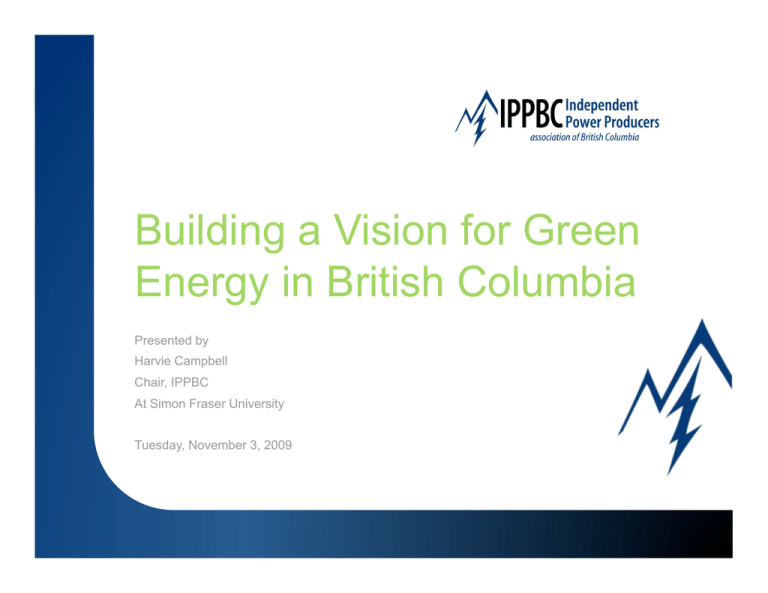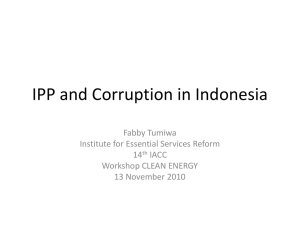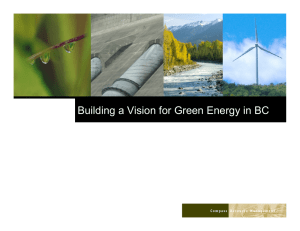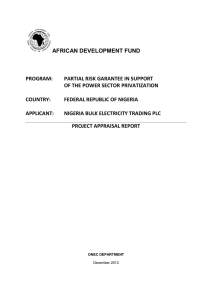Building a Vision for Green Energy in British Columbia Presented by Harvie Campbell
advertisement

Building a Vision for Green Energy in British Columbia Presented by Harvie Campbell Chair, IPPBC At Simon Fraser University Tuesday, November 3, 2009 Agenda • Who we are & what we do • Opportunities for IPP development in B.C. • Benefits of IPPs in B.C. – Economic – Environmental – Social • Why we are on the right path • Future direction of IPPs in B.C. Points to take away 1) Clean energy development drives economic growth, job creation and investment for First Nations and rural communities, for the benefit of all British Columbians 2) Clean energy combats climate change by significantly reducing our carbon footprint 3) All independent power projects undergo rigorous environmental reviews under provincial and federal environmental legislation 4) B.C.’s publicly-owned electricity infrastructure, augmented with private sector generation, delivers the most cost-effective electricity to British Columbians WHO WE ARE & WHAT WE DO IPPBC Association • Started in 1991 • Non-profit and volunteer driven • 330 members – All clean energy – Lead by IPP developers – Includes service providers • Engineers, builders, equipment vendors, fuel suppliers • Environmental firms, lawyers, financiers and consultants • Voice of IPPs – Policy and regulator advocate B.C.’s IPP Industry • 46 operating plants, spread all over B.C. – 36 small hydro @ 10 MW (average) – 4 biomass @24 MW (average) – 4 biogas @ 3 MW (average) – 2 gas @ 175 MW (average) – No coal, nuclear, or geothermal • Supply 9% of B.C.’s electricity energy • Oldest IPP began operating in 1992 First Nations-owned China Creek hydroelectric project Wind project in the Peace Island Co-gen Plant in Campbell River Williams Lake woodwaste fired power project OPPORTUNITIES FOR IPP DEVELOPMENT IN B.C. Need to fill the Supply Gap • B.C.’s energy needs today and tomorrow – Approximately 50,000 GW hours/year produced from B.C. resources (critical water year) – Present day demand is around 59,000 GW hours/year – The gap is 9,000 GW hours (15% of demand) – Could rise to 20% within 5 years BCH Supply Gap Domestic Requirements GWh 70000 65000 60000 } 55000 50000 2007 Imports 6,141 GWh 45000 Actual BCH Forecast Historical Growth Supply B.C. has a competitive advantage in clean energy • Abundance of natural resources • B.C. only jurisdiction to offer wind, biomass and runof-river Hydro in one place • Homegrown innovation and technology • A balance of publicly-owned generation and transmission assets augmented with privately-owned generation B.C. has a competitive advantage in clean energy (cont...) • Construction, operation and financial risk is absorbed by IPPs, not taxpayers • Public wants clean forms of energy • On the doorstep of the U.S. – where RPSs are driving demand for renewables WE ARE ON THE RIGHT PATH Benefits of IPPs in B.C. • Economic: Helps create a “green economy” • Environmental: Tackles climate change and reduces GHGs • Social: Fosters First Nations and community participation and benefits Economic Benefits of IPPs • By 2020, investment in B.C.’s IPP sector could reach $29 billion • IPP construction could support 90,000 person years of employment for British Columbians by 2020, and more than 8,100 full time jobs to support their operations • By 2020, the construction of IPPs could contribute up to $1.7 billion to all three levels of government in B.C., while annual direct payments to government could reach half a billion IPPs position B.C. to be a leader in fight against global warming • Reduce GHG emissions – To date, B.C.’s operating IPPs have enabled an annual reduction of 4 million tonnes of GHGs that would otherwise have resulted from B.C. Importing power from thermal plants in Alberta and the U.S. • Reduce our environmental footprint • Projects must undergo stringent environmental assessment and oversight See how far we have come in tackling climate change False Creek in 1930’s False Creek in 2000 Let’s keep going! Social Benefits of IPPs First Nations participation • First Nations involvement high and a “must have” • Partnerships are taking place with First Nations in every region of B.C. • Helps support a New Relationship with First Nations Community participation • New revenue stream • Supports local businesses • Jobs within communities mean people do not have to be away from their families to earn a living • Provides options and hope to families in single industry towns FUTURE DIRECTION OF IPPS IN B.C. Clean power is no longer a niceto-do, it’s a must do • Clean energy development can play a critical role in BC’s economic future and quality of life while reducing our carbon footprint. • The supply gap in B.C. remains an issue - this despite the tremendous potential of the province • Provincial policy is sound - the focus must be on streamlining the decision making process and implementation • It is not “Vancouver” warming, “Victoria” warming or “Prince George” warming – it is “GLOBAL” warming • Continued importance of collaboration – i.e. Green Energy Task Force, B.C. Bioenergy Network • B.C. must secure its position as a North American leader in clean energy










